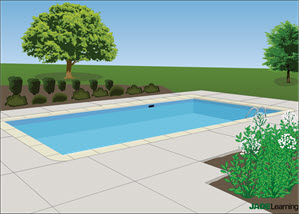The 2020 NEC Allows Electrical Inspectors to Periodically Inspect Swimming Pools and Similar Equipment, after Installation.

By: Jerry Durham | Jan 07, 2020
680.4 Swimming Pools, Fountains, & Similar Installations. Inspections After Installations.
The 2020 Code Making Panel has introduced a new and unprecedented Code section for this 2020 Code cycle that may prove controversial once time allows this directive to play out.
This new requirement found in Section 680.4 of the 2020 NEC allows the Authority Having Jurisdiction (AHJ) to return to a home or business for follow-up inspection(s) even after the swimming pool, fountain, or similar has passed final inspection, and the job is complete.
The Code section reads:
680.4 Inspections After Installation.
The authority having jurisdiction shall be permitted to require periodic inspection and testing.
Groundbreaking for the NEC
The idea of granting permission for electrical inspectors to return periodically, indefinitely after the electrical installation and applicable inspections are complete, is new for the National Electrical Code.
The reasoning for such radical new permission(s) is rooted in the understanding that swimming pools are liquid conductors. The water in the pool that is capable of carrying electrical current passes through one or more electric pumps; is illuminated by one or more submerged electric luminaires, and is in contact with the earth, which can periodically experience surging voltage.
Should the equipotential bonding plane surrounding the swimming pool, or the insulators separating electric pumps and electric lighting from the conductive water in the pool ever fail, the swimmers occupying the pool could be exposed to electrical hazards resulting in injury or death.
Equipotential Plane
The NEC requires an equipotential bonding plane to be assembled outside the swimming pool under the walkway surface surrounding the pool for an area measuring 3 feet outward from the swimming pool interior wall. This conductor
installed under the walkway must then attach to all other conductive exposed metals measuring within 5 feet of that same interior pool wall.
The materials allowed to serve as the conductor under the walkway surface are:
- Structural reinforcing steel
- 8 AWG solid copper bare conductor encircling the pool
- Copper grid
Whatever material the electrician uses, it must connect to the swimming pool outer reinforcing shell at four equally spaced points, if that pool shell is a conductive metal material.
Bonding Within 5 feet of the Pool Wall
Once the grid or conductor material is under the walkway surrounding the pool and connected to the outer pool shell, any exposed metal within 5 feet of the surrounding interior pool wall must also be bonded to that underground conductor system by a No. 8 AWG copper conductor. This includes metal pool ladders, metal fencing, doors, window frames, and even steel conduit or cable within the first 5 feet surrounding the pool. This bonding requirement also extends to the pool electrical equipment and applicable lighting, minus any double-insulated water pump motors and pool water heaters greater than 50 amps, that have their own special bonding requirements from the manufacturer.
Deterioration of the Pool Equipotential Bonding System
The reason this elaborate equipotential system is built that connects all exposed metal surrounding the pool to the water in the pool, and to the surrounding earth is to manufacture a complete conductive path for current to flow between these components. This way, in the event of inadvertent voltage coming into contact with any single component, the voltage will ultimately energize all components. This continuity between parts reduces or even eliminates the deadly voltage gradient existing between conductive materials that can electrocute a swimmer, should swimming pool components come into contact with dangerous voltage.
Remember, it is the difference in voltage or gradient on conductive surfaces that forces electrons through the human body and causes electrocution, when inadvertent contact is made; it is not the voltage itself. Just like a bird safely perched atop an exposed street-side utility wire, a human being can safely come into contact with voltage as well, as long as that person makes no contact with a nearby surface of a different voltage.
Experts understand that deterioration can occur to the conductors, fittings, and connections that make up the equipotential bonding plane surrounding a swimming pool. With deterioration comes an increased risk of electric shock.
Physical inspection of all exposed connections and conductors, along with metered testing of continuity and resistance in Ohms along the bonded conductive parts can validate the effectiveness of an older equipotential bonding plane. It is for this reason that the NEC has included permission for the AHJ in the 2020 Code cycle to perform periodic inspecting and testing of pools and similar water-based equipment.



680.4 should never have been put into code. This will keep 2020 NEC from being adopted in several states. Once that final sticker goes on an electrical inspector has NO BUSINESS attempting to enter private property. The public does not need over reach from already over powerful government. I personally will be having our company lawyer working to prevent Montana from adopting 2020 NEC. Time for the code making people to pull their heads out and realize this could lead to significant problems.
I for one would like to know how many homeowners are willing to go through this exercise. It’s hard enough to convince someone to pay a third party $150 to inspect the install in the first place, let alone to permit another form of government oversite. (or money grab if you like)
I specialize in wiring pools. We wired 136 pools in 2019. I think that follow up inspections can make people safer but it must be done professionally. There is a ‘Trespassing’ concern to think about?
Can’t the same logic can be applied to other installations as well (how about a meter can check to make sure water isn’t getting in)?
Also, what if something does change or corrode and someone gets hurt on the property? Can my lawyer drag in the inspector as he had at least some responsibility to insure the integrity of the system in perpetuity?
To claim to allow the re inspection, which the NEC doesn’t have the authority to do unless they are claiming ownership of said items, I could see it being a suggestion like every other manufacture item has. Electrical installs are, manufacturing a product on site. There will be push back from the homeowners and the county.
If that is actually supported by jurisdictions, how long before breaker manufacturers demand the same for their panels and AFCI breakers post-final?
A good reason for a homeowner NOT to install a swimming pool.
I’m installing an above ground pool and the electrical inspector is telling me that my central AC unit must be at least 10 ft away from the inside pool wall. I can’t find the article in the car de book where it states this? Any help here?? Thanks
5′ or closer has to be bonded to the common grid of pool system
Art.680.26(B)(5)
You can actually have it closer then 10 feet
If it’s out side of the 5′ not required
He is required to state the code violation if he is going to not pass it, cannot just make rules up